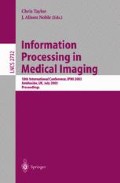Abstract
Localizing and quantifying the sources of ElectroEncephalo-Graphy (EEG) and MagnetoEncephaloGraphy (MEG) measurements is an ill-posed inverse problem, whose solution requires a spatial regularization involving both anatomical and functional priors. The distributed source model enables the introduction of such constraints. However, the resulting solution is unstable since the equation system one has to solve is badly conditioned and under-determined. We propose an original approach for solving the inverse problem, that allows to deal with a better-determined system and to temper the influence of priors according to their consistency with the measured EEG/MEG data. This Localization Estimation Algorithm (LEA) estimates the amplitude of a selected subset of sources, which are localized based on a prior distribution of activation probability. LEA is evaluated through numerical simulations and compared to a classical Weighted Minimum Norm estimation.
Access this chapter
Tax calculation will be finalised at checkout
Purchases are for personal use only
Preview
Unable to display preview. Download preview PDF.
References
Baillet, S., Mosher, J.C., Leahy, R.M.: Electromagnetic brain mapping. IEEE Sign. Proc. Mag. 18, 14–30 (2001)
Koles, Z.J.: Trends in EEG source localization. Electroenceph. Clin. Neurophysiol. 106, 219–230 (1998)
Dale, A.M., Sereno, M.: Improved localization of cortical activity by combining EEG and MEG with MRI surface reconstruction: a linear approach. J. Cognit. Neurosci. 5, 162–176 (1993)
Pascual-Marqui, R.D.: Review of methods for solving the EEG inverse problem. Int. J. Bioelectromagnetism 1, 75–86 (1999), http://www.tut.fi/ijbem
Baillet, S., Garnero, L.: A bayesian approach to introducing anatomo-functional priors in the EEG/MEG inverse problem. IEEE Trans. Biomed. Eng. 44, 374–385 (1997)
Ermer, J.J., Mosher, J.C., Baillet, S., Leahy, R.M.: Rapidly recomputable EEG forward models for realistic head shapes. Phys. Med. Biol. 46, 1265–1281 (2001)
Liu, A.K., Belliveau, J.W., Dale, A.M.: Spatiotemporal imaging of human activity using functional MRI constrained magnetoencephalography data: Monte Carlo simulations. Proc. Natl. Acad. Sci. U.S.A. 95, 8945–8950 (1998)
Mattout, J., Pélégrini-Issac, M., Garnero, L., Benali, H.: Multivariate source localization approach for MEG/EEG inverse problem. Neuroimage 13, S196 (2001)
Mattout, J., Pélégrini-Issac, M., Garnero, L., Benali, H.: Statistical method for sources localization in MEG/EEG tomographic reconstruction. In: Proceedings of the IEEE International Conference on Image Processing, vol. 1, pp. 714–717 (2001)
Sarvas, J.: Basic mathematical and electromagnetic concepts of the biomagnetic inverse problem. Phys. Med. Biol. 32, 11–22 (1987)
Gorodnitsky, I.F., George, J.S., Rao, B.D.: Neuromagnetic source imaging with focuss: a recursive weighted minimum norm algorithm. Electroenceph. Clin. Neurophysiol. 95, 231–251 (1995)
Phillips, C., Rugg, M.D., Friston, K.J.: Anatomically informed basis functions for EEG source localization: Combining functional and anatomical constraints. Neuroimage 16, 678–695 (2002)
Logothetis, N.K., Pauls, J., Augath, M., Trinath, T., Oettermann, A.: Neurophysiological investigation of the basis of the fMRI signal. Nature 412, 150–157 (2001)
Nunez, P.L., Silberstein, R.B.: On the relationship of synaptic activity to macroscopic measurments: does co-registration of EEG with fMRI make sense? Brain Topogr. 13, 79–96 (2000)
Phillips, C., Rugg, M.D., Friston, K.J.: Systematic regularisation of linear inverse solutions of the EEG source localisation problem. Neuroimage 17, 287–301 (2002)
Author information
Authors and Affiliations
Editor information
Editors and Affiliations
Rights and permissions
Copyright information
© 2003 Springer-Verlag Berlin Heidelberg
About this paper
Cite this paper
Mattout, J., Pélégrini-Issac, M., Bellio, A., Daunizeau, J., Benali, H. (2003). Localization Estimation Algorithm (LEA): A Supervised Prior-Based Approach for Solving the EEG/MEG Inverse Problem. In: Taylor, C., Noble, J.A. (eds) Information Processing in Medical Imaging. IPMI 2003. Lecture Notes in Computer Science, vol 2732. Springer, Berlin, Heidelberg. https://doi.org/10.1007/978-3-540-45087-0_45
Download citation
DOI: https://doi.org/10.1007/978-3-540-45087-0_45
Publisher Name: Springer, Berlin, Heidelberg
Print ISBN: 978-3-540-40560-3
Online ISBN: 978-3-540-45087-0
eBook Packages: Springer Book Archive

